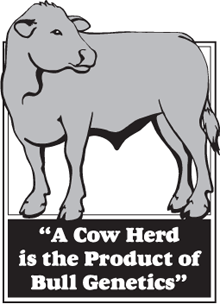



Easier to Haul Home a New Bull Than a New Cow Herd
As a producer, you really do not know if the individual animal performance is more a function of selected genes or unique management.
A fundamental question was asked the other day. Why not pay more attention to the offspring of the bull when a producer is re-evaluating the bull pen rather than the current predicted performance of the bull?
This question is a very good and relevant question in the context of overall beef production. The reality of managing a beef cattle operation has many daily demands in terms of inputs and outputs.
There is no simple process to place a calf up for sale, so, for at least today, let's continue to focus on genetics because the bull buying season is upon us. The evaluation of a bull's progeny would be and is another component of understanding if a bull is the right one.
Unfortunately, the question is a lot easier to ask than answer. These concerns should lead a producer to a fork in the road. One fork points to breed associations and utilizes their expertise in sorting and reporting correct genetic feedback.
The other fork points to cow management and calf evaluations. These are two unique and different data functions and clearly have different outcomes.
Bull buying focuses on the first fork, so the information only is as good as the ability of the breed associations to analyze the data and report results. Once calculated and expressed as an expected progeny difference (EPD), the ability to predict the genetic potential of a particular bull is excellent.
The second fork is in the herd process. As genes are placed in the cow herd, the performance of those genes is dependent on cow herd management. The associated records collected within a cow herd are more related to managerial questions, not genetic questions. Therefore, most records have the management of the herd and the genetics of the herd confounded.
In other words, as a producer, you really do not know if the individual animal performance is more a function of selected genes or unique management. Both are important.
The obvious response would be that what a producer sees is what a producer gets. The overwhelming comfort level tends to accept what is seen over what the EPDs predicted.
Normally, they do agree, but not always. However, it is better to accept the breed association’s predictions when evaluating the progeny of a bull. Yes, that causes consternation, but, amazingly, large data sets do predict with great accuracy the answer to the question.
Use EPDs generated by breed associations to buy bulls. Use herd management records to manage cows. In a pure world, all the bulls would be individually mated to a known group of cows. The calves would all be tagged and documented and the data collected. However, most cattle are group mated. In other words, more than one bull is turned out to a group of cows or the bulls are rotated. This provides some level of assurance that the cows will be exposed to a fertile bull.
In these cases, the individual sire of the calves is not known and most cattle are not randomly mated within a herd. In other words, when comparing calves, the parents of those calves were selected through specific mating plans and the evaluation of the calf is an affirmation of the plan.
If the calf does not meet expectations, it is the plan that needs to be revised, not the data going into the plan. Both the cow and bull contribute to the plan, but the known accuracy of a genetic prediction generally is greater for the sire than the dam.
In addition, a yearling bull that conceives a calf will be 2 years old when the calf is born. He will be 3 years old when the calf is more than likely harvested and he already will have conceived his third set of calves before the harvest data is analyzed from the first set of calves the bull sired.
No wonder the data needs to be right at the time of purchase. Finally, although predicted performance is utilized to buy bulls and to re-evaluate bulls, cow performance is important.
However, in the big picture, a cow herd is the product of bull genetics and it is a lot easier to haul home a new bull than a new cow herd.
May you find all your ear tags.
March 2009


